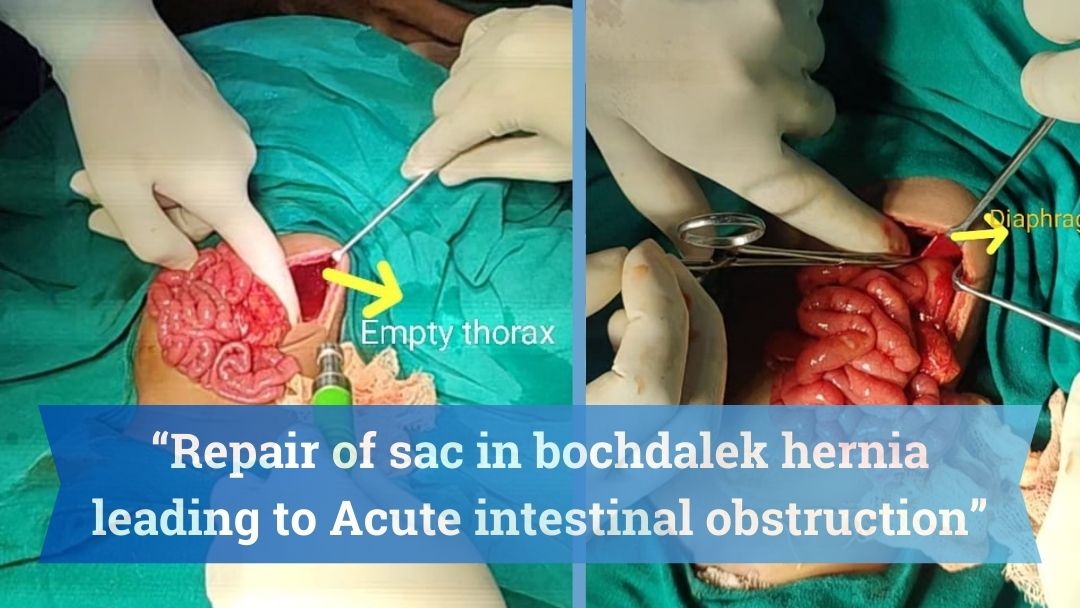Introduction
Bochdalek hernia usually presents in neonates with respiratory distress. Almost 10-20% of such cases present at later age groups. Common presentations of such late cases are non-specific gastrointestinal and respiratory symptoms. Presentation with acute intestinal obstruction is extremely rare. We report one such case in a six month old male infant with rupture of hernia sac as the catastrophic event leading to acute gastrointestinal obstruction.
Case report
A six day old male infant was referred to us with complaints of abdominal distention, bilious vomiting and constipation since two days. He was first child of his parents. He was born out of non-consanguineous marriage and had uneventful perinatal and neonatal period. On examination, child had tachypnoea, abdominal distension with exaggerated bowel sounds and absent air entry on left side with shifting of heart sounds to right. Erect X-ray abdomen with chest (Fig.1) was done. It showed left sided diaphragmatic hernia with mediastinal shift to right and multiple air fluid levels in abdomen with absent gas in pelvis. While the patient was being stabilized and resuscitated, we got a contrast enhanced computed tomography of abdomen and chest done (Fig. 2). It showed a small posterolateral defect in left hemidiaphragm with herniation of large intestine, greater omentum, spleen and part of stomach. After stabilization, laparotomy was done via left subcostal approach. Incarcerated contents (transverse colon, greater omentum, part of stomach and spleen) were slowly and gently reduced through the tight diaphragmatic defect. The reduced contents had preserved vascularity and there was no associated malrotation of gut. At this stage we could appreciate that the hernia had a well defined sac, and the sac had a defect of 2X2cms at its dome, through which the contents had migrated into the pleural cavity. Anterior and posterior lips of the diaphraghmatic defect were approximated with polypropelene 3-0 intermittent sutures and plicated sac was incorporated in this repair.

Figure 1a Defect in left diaphragm.
DISCUSSION— Obsebold & soper in his article The late presenting paediatric Nochdalek Hernia since 20 years review claimed that 5% of diaphragmatic hernias present beyond neonatal period in one group it is suggested that the defect is long-standing but the viscera are confined by a hernia sac or obturated by a solid organ.

Figure 1b Contents in hernia.
Presentation occurs when the sac ruptures or intraabdominal pressure is raised. Diaphragmatic hernia with acute gastro-intestinal obstruction, respiratory distress compression of the lungs & mediastinal shift is caused due to distension of incarcerated stomach or intestine. Vomiting& altered general status are presenting symptoms in acute gastro-intestinal obstruction. Plan x-ray for diagnosis of acute gastro-intestinal obstruction. Respiratory support is most important in management of CDH. Support by nasal prongs or bag-mask can lead to distension of abdomen & compression of the lungs so should be avoided. Patient with respiratory distress should be intubated & ventilated with low peak inspiratory pressure & minimize lung injury. Nasogastric tube used for continuous suction placed in stomach to decompress abdominal contents.
In our patient Surgery was performed via open technique with left subcostal approach. Incarcenated contents (transverse colon, greater omentum, parts of stomach & spleen) were slowly & gently reduced through the tight diaphragmatic defect. The reduced contents had preserved vascularity & there was no associated malrotation of gut. At this stage we appreciated the hernia wall had a well definedsac, & thesac had a defect of 2X2 cms at its dome,through which the contents hed migrated into the pleural cavity.Anterior & posterior lips of the diaphraghmatic defect were approximated with prolypropelene 3-0 intermittent sutures & plicated sacwas incorporated in this repair
Laparoscopic or thoracoscopic approach is preferred these days in delayed presentation of CDH as minimally invasive approach could be safe alternative to laparotomy instable children with CDH.
CONCLUSION—Delayed presentation with obstruction is potentially life threatening CDH. Due to presenting clinical & radiological features cases may get misdiagnosed. The early differential diagnosis & decision of laparotomy & reduction of contents is most important factor in achieving diagnostic success. With no E/O Down’s Syndrome.



